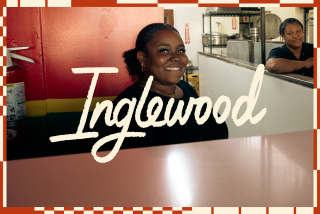Suburbia Lives on Here--and Proudly : Downey: Residents are pleased with the low crime rate, tranquil atmosphere. And the city’s reputation for good schools draws families with children.
- Share via
When Juanita Parada and her husband, John, moved to Downey from neighboring South Gate last year, they traveled a short distance to find what they view as a world of difference.
“I couldn’t picture myself living anywhere else,” she says now, and she’s not alone.
Downey residents, new and old alike, speak reverently about their community. They are proud of the Downey Unified School District, which draws young parents to Downey to raise their children. They are proud of their city’s high home prices and its low crime rate.
“People are more relaxed in Downey than in other nearby communities because it’s a safer neighborhood,” said Parada, who lives in north Downey.
Downey, with a population of 88,000, is only a dozen miles southeast of downtown Los Angeles. It has managed to retain much of what living in American suburbia used to mean, its residents say.
The city is the second oldest Anglo settlement in California, and the community has remained largely Anglo in its demographic composition.
Surrounded by two riverbeds--the Rio Hondo and the San Gabriel--and three freeways--the Santa Ana on the north, the 605 on the east and the Long Beach on the west--Downey has escaped much of the change that has robbed many of Los Angeles County’s communities of their tranquility.
And the residents like it that way.
“The point is that if you’re looking to establish a home, you want security and you want to feel like you’re not going to have graffiti and crime at your door,” said Barbara Callarman, who moved to Downey in 1961.
Downey, created in the 1860s when John G. Downey, governor of California from 1860 to 1862, subdivided Rancho Santa Gertrudis, was a farming community. It began to develop in the 1950s and ‘60s with the growth of the aircraft industry.
The city is divided into north and south by railroad tracks, and to live in North Downey, particularly northeast Downey--north of Florence Avenue and east of Lakewood Boulevard--is considered to be living on the “right” side of the tracks.
“When I first moved to Downey, I started out on the southernmost tip, and with each move, I moved farther inward,” said Maria Larkin, president of Century 21 American Realty and a Downey resident since 1957.
“My goal was ultimately to live in northeast Downey, because when you grow up (here) your goal is to one day have a big beautiful home.”
But not everyone who wants to live in Downey can afford to be choosy about which neighborhood to buy in.
According to Larkin, the houses in the northeast area begin in the $400,000-range and go up well more than $1 million. Fixer-uppers can be found for $300,000, she said.
In an area of south Downey popular with first-time buyers, a two-bedroom, one-bathroom, single-car garage home--in a tract built for the GIs coming home from World War II--will start at about $180,000.
According to Margie Richey of Red Carpet Realty, a three-bedroom, 1 1/2- or two-bath tract home would cost between $214,000 and $850,000 in northwest Downey, an area north of Firestone Boulevard and west of Downey Avenue.
The same-size home in the southwest section of Downey that borders the city of Paramount--south of Firestone Boulevard and west of Downey Avenue--costs between $210,000 and $450,000. In southeast Downey, which borders the city of Bellflower--south of Firestone and east of Downey--where the homes are slightly smaller, a similar home costs anywhere from $194,000 to $318,000.
But north or south, residents single out the Downey Unified School District as a compelling reason for young parents to choose to raise their children in Downey.
“We moved to Downey to be in a better school district,” said Nancy Merrik, who moved to North Downey from South Gate a few months ago with her husband and two children. The bought a house for $250,000, the starting price in their new neighborhood.
“In the middle and elementary schools they hold their PTA meetings in the morning, so I’m able to participate without taking away from the family’s time together,” she said. “I guess they can do this because they have so many women who don’t work.”
“Our standardized test scores have been well above state and national levels,” said School Supt. Edward Sussman. “. . . 62% of our graduating seniors go on to college,” he said, compared to the national average of 55%.
Downey unified’s success rate is largely attributable to personalized approaches in dealing with students--an outgrowth of what Sussman described as “strong positive community support.”
But good schools are not the only reason for Downey’s popularity. Safety is another.
“I consider Downey a very safe community,” Merrik said. “In Downey, we walk every night, where as the last two years in South Gate, we became real aware of when and where we could and couldn’t walk.”
According to the Downey Police Department, many of the problems facing the surrounding communities--gang violence, drug problems and violent crime--have not hit Downey as hard.
“Downey does have all types of problems, they’re just on a smaller scale,” said Sgt. Roy Campos. “The numbers of crimes haven’t gone up that dramatically, but like everywhere else, there has been an increase in violent crime. . . .”
But because Downey has its own police department, Campos said, the city is able to deliver quicker service. “Any evening we could have 16 to 18 police units in the street for a 12.7 square miles,” he said. “That’s a good average.”
Residents attribute the relative absence of crime to the lack of night life in Downey. And for some of the city’s younger residents, this is a trade-off they are not willing to make.
“My own children said they would not want to live in Downey because it’s too boring,” Barbara Callarman said.
“Growing up, my son thought that Downey was a stuffy old town,” Gordon Madru, a longtime resident and volunteer for the Downey Historical Society, said. “But now that he lives here, he likes that Downey sort of rolls up the sidewalk at night.”
“I can remember as a lady in my 20s, I’d have to go out of Downey for my entertainment,” realtor Maria Larkin recalled. “No dance halls and things like that. I think that’s one of the reasons Downey stays clean.”
Remaining clean, quiet and virtually graffiti-free is a priority that Downey residents uphold.
“Downey is a community where if someone were to move in and didn’t keep up to the standards, the people would do something about it,” Merrik said. “The civic pride is so strong that even if you’re odd man out, you would almost have to come around.”
Another reason for Downey’s suburban feel is that most of the residents work outside of Downey’s boundaries.
While Downey is home to Rockwell North American--the developer of America’s Space Shuttle project--plastics manufacturing and food manufacturing, there is little industry within Downey’s borders. So, for most of its residents, Downey is simply home.
“The reason we moved here in 1961 is because my husband worked in City of Commerce,” Barbara Callarman said. “Downey is freeway-close to any place, but the freeways don’t ruin your life.”
But because Downey is largely an Anglo community, the influx of nonwhite residents in the last decade, albeit limited, has served as a reminder to many there that they are a part of a greater California Community.
“Downey has been a very caring community,” said Doris Patterson, president of the Chamber of Commerce. “We are trying very hard to integrate all segments of the society into life in Downey.”
“This influx of diversity of people helps everyone here,” said Sgt. Compos. “It teaches the people here what is out there in the southwestern United States. It’s good for common human interaction.”
But for most of Downey’s residents, the status quo is much preferred to change.
And it is in this spirit that Downey remains the home of the oldest existing original McDonald’s, complete with the gold arches, at the corner of Lakewood Boulevard and Florence Avenue. According to John Vincent, president of the Downey Historical Society, very little about Downey is a coincidence.
“The Planning Commission of the Downey City Council planned for the future,” Vincent said, “and it worked.”
AT A GLANCE Population
1989 estimate: 87,877
1980-89 change: 6.4%
Median age: 35.4 years
Racial/ethnic mix
White (non-Latino): 70.2%
Latino: 23.1%
Other: 5.7%
Black: 1.0%
Annual income
Per capita: 14,536
Median household: 32,408
Household distribution
Less than $15,000: 20.2%
$15,000 - $30,000: 26.0%
$30,000 - $50,000: 29.4%
$50,000 - $75,000: 16.4%
$75,000 +: 8.0%
Home price
Nov. ’89 average: $225,843
More to Read
Sign up for Essential California
The most important California stories and recommendations in your inbox every morning.
You may occasionally receive promotional content from the Los Angeles Times.













